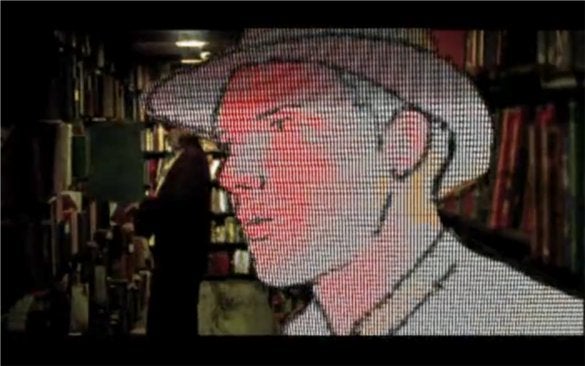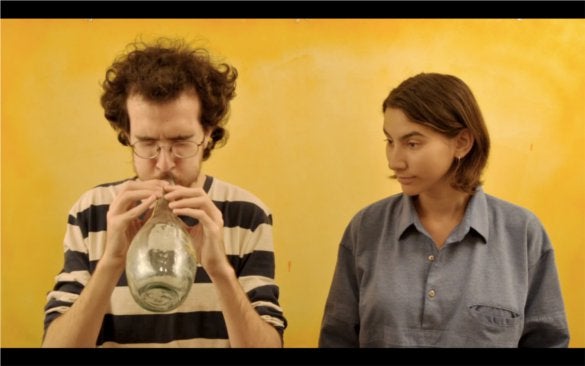
Let’s be frank: these days a trip to the movies often ends in more disappointment than intellectual stimulation and wonder. Last night, however, my film-watching experience blew me away. I attended the Disposable Film Festival in San Francisco, an event which showcases movies that all have one amazing thing in common: none were shot on a traditional video camera. Smart phones, web-cams, DSLR cams, wearable recorders, and screen capture software were all used to create short films that are as incredible in their diversity and story-telling, as they are in their cinematography. Of over 2000 submissions to this year’s festival, DFF selected just 18 to appear at their opening night. It is with great relish that I offer those videos, in their entirety, and in the order in which they were presented, for you to watch at the end of this post. Most are short (less than 3 minutes), many are quirky, but all are great examples of how cinema is leaving Hollywood and coming to live in each of our hands.
The prevalence of cameras in the world is becoming absurd. Digital image capturing technology is now so small and of such high quality that we no longer marvel at phones that shoot in higher resolution than dedicated video cameras did just a few years ago. At its core the Disposable Film Festival celebrates the democratization of movie making that comes with the spread of camera technology. Your phone can now be the means by which you join the film industry. So, too can your web-cam serve as an entry point into visual story-telling, as we see time and again with online video sharing sites like YouTube and Vimeo. It no longer takes millions of dollars to shoot a film that will be watched by millions of people. Talent, experience, hard work – those are still non-negotiable, but cinema in the 21st Century can be created by anyone with a few hundred bucks and a story to tell. While there is still an enormous range in the quality and cost of films (and always will be, I suspect), the democratization of film is here, and it continues to spread around the globe at phenomenal rates.
2012 is the fifth year of DFF, and in its relatively short history it has evolved from small screenings for a hundred people to the 1400 person event I watched Thursday night. Submissions have increased incredibly as well, up from 1200 last year to 2000 in 2012. “The number and quality of entries this year surpassed anything we’ve seen before,” said Carlton Evans, Co-Founder. “People across the globe are finding themselves empowered through new inexpensive video technologies. And they’re using them to tell their stories.” The international nature of DFF is clear, with selected films coming from France, Israel, the UK, and Norway as well as the US.
The festival continues through the weekend, with panels on travel videos, enabling youth involved in this new mode of film-making, and social action (the importance of the “Arab Spring” is on everyone’s mind). There’s also a discussion on copyrights, and intellectual property – an important panel to have when a good portion of the selected films utilize footage shot by others. DFF’s “Screen Capture” films edit, modify, and remix previous movies (many famous) or reuse footage taken for public service or other purposes. A growing paradigm of the video creation in the 21st Century is this compilation approach to artistic creation. It’s seen constantly on YouTube, and is overwhelming prevalent in the musical world as well. The quality and ingenuity of the Screen Capture films from DFF show why this blossoming branch of cinema must be protected, even as the industry struggles to define their rights.

Because if we lose movies like the ones below, we lose an incredible evolutionary step in the history of cinema. These films, as you are about to see, cover a range of genres that is simply delightful: horror, romance, documentary, science fiction, music video and more. The individual ideas for each video are also amazingly unique and diverse. With non-traditional filming techniques these artists were able to take chances and create short films that no major studio would have taken the risk to finance. As movie-goers we are able to see cinema far outside the Hollywood norm because now almost any idea can be shared. That’s an opportunity whose possible benefits far outweigh the problems of intellectual property and profit.
Not sure you’d agree? Well, let’s let the Disposable Film Festival speak for itself. The following 18 films are presented just as I saw them, sans the transitional credits and witty commentary of the festival’s organizers. I’ve included the run time and technology for each, in case you only want to watch a few, but I highly recommend setting aside 80 minutes or so and enjoying all of them at once:
An Open Letter to Canon by Doug Bayne, shot on a Canon DSLR camera. (2:05)
Splitscreen: A Love Story by James W. Griffiths, shot on a Nokia N8 mobile phone (2:25). 2nd Place Winner at DFF 2012.
The Adventures of a Cardboard Box by Temujin Doran, shot on a Nokia N8. (8:00)
Old Flames by Ken Alshatti, shot using screen capture techniques. (1:13)
The Ramshackle Union Band by Arran Shearing, shot on multiple devices (2:45).
Les Ongles (The Nails) by Clement Deneux, shot on a mobile phone (7:48). 1st Place Winner at DFF 2012.
Time is of the Essence by Andre Chocron, shot using screen capture techniques (3:49).
Bottles by Ada Rimon, shot using a DSLR camera (0:50). *A personal favorite!*
Lil’ Aliens by Peter Ahern and Andy London, shot on DSLR camera (2:21)
Synchronize by Elise The, shot using screen capture techniques (2:49).
Webcam by Branden Kramer, shot using webcams (7:49).
Gonzo Calling by Sascha Ciezata, shot using a DSLR camera (1:28).
Dans l’ombre ( In the Shadow) by Fabrice Mathieu, shot using screen capture techniques (7:47). Honorable Mention at DFF 2012.
Subwaltz by Andrea Allen, shot using a Vado HD pocket video camera (1:32).
Proteigon by Steven Briand, shot using a DSLR camera (1:30) *I could watch this all day*
DVD Commentary by John & Richard Ramsey. These two brothers have dubbed a DVD-style commentary onto an old home movie. (2:00)
The Voyagers by Penny Lane, shot using screen capture techniques (16:30). Given to her husband as a wedding gift. Honorable Mention at DFF 2012. *A must-see for anyone who believes in space-exploration*
Laughs by Daniel Mercadante, compiled from clips on YouTube (2:10)
…and there you have it folks. An entire festival at your fingertips. If, however, you are like me and want the big-theater experience, the Disposable Film Festival is taking these selections on the road. Check their events page regularly to learn more about where and when DFF will appear next (past destinations include L.A., London, New York City, and many more locations around the globe).
*Special thanks to Miles Christian Daniels and Amber Kaplan for their assistance, and to Carlton Evans and Katie Gillum for putting on such a wonderful event.*
[image credits: Provided by DFF2012: “Synchronize” still by Elise The, “Bottles” still by Ofeq Shemer and Ada Rimon]
[source: The Disposable Film Festival, Miles Christian Daniels]



